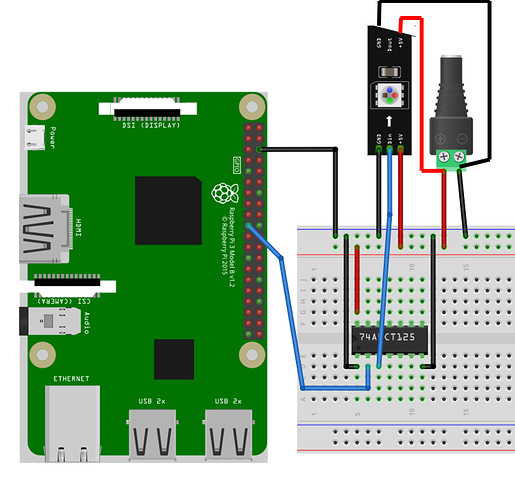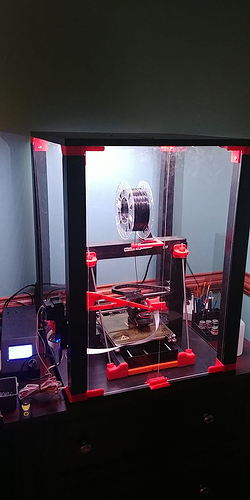Looking good! I like the look of a black PCB. Probably makes the contrast with the lights stronger.
Feel free to release the files yourself somewhere - then you can have full ownership to explain and update with whatever you see fit. I can then provide a link to them from the plugins, or if you don't want to do this, I can probably host them on Github near the plugin itself.
Thanks gents. I'll have to do some reading up on gcode..haven't messed with it much.
Another question for you all, hopefully you can help. I purchased BTF-LIGHTING WS2812B RGB 5050SMD LED lights from Amazon (https://www.amazon.com/gp/product/B01CDTEJBG/ref=ppx_yo_dt_b_asin_title_o06_s00?ie=UTF8&psc=1) I've got a 162 light set running on a 10W power supply. Should be enough to power that amount of LED's.
I get color mismatch on white, about halfway down the strip, it starts going from a bright white, to a yellow white. Front of the strip measures ~5V, end of strip measures ~3V. Why am I witnessing that much drop in the strip? No significant change in color w/ R/G/B tested.
Would a larger 100W power supply help?
FYI - I'm running the LED strip settings at 50% max brightness which seems to help
If you search the internet for 'power injection' you'll find what you need. It's caused by voltage drop, as you noticed, so to eliminate that you can do something like power the strip from both ends. The cabling you use for that will have a lower resistance, so it will not drop the voltage.
You can inject power on any of the contacts along ws281x LEDs, so I think the recommendation is that you inject power every 100 or so.
Thanks Charlie. Sorry about being a bother on this, I'm out of my league, but learning a ton, which is awesome. Looking into power injection, I see no reason that I can not use the same 5V10A power supply to inject power down-stream of the LED strip. 10 Amps should power 162 LEDs on full brightIn fact, I've seen some tutorials that say you can inject at the end of the WS2812 strip with the built in connection and accomplish the same thing (not sure how that works though... to me it seems like they have +5V coming into the same pipe from both directions - which doesn't seem right.
If I can use the same 10A power supply, would this setup work? Or would i have to cut the +5V line somewhere in the middle of the strip, but maintain ground connection throughout, so that I don't have 5V at both ends of the "pipe"
Thanks much for the help!
That should work by the picture, same power supply. No need to cut the 5V, just connect the same supply to both ends. 10 amps is plenty - I have a 10A supply, and have not run into issues beyond voltage drop.
Here's an image of my setup. Thanks Charlie for the help!
Works well so far. I put the @WS_TORCH line in g-code through cura - inserted prior to each layer change. This doesn't work perfeclty for octolapse. Need to figure out how to get octolapse to insert that code prior to picture being taken. More reading to do.
Overall happy with the status color change w/ the LED strips.
1 Like
@FlynHokie Since you are not the first or last person to talk about this, there is now a handy guide over on the wiki:
1 Like
Quick update on this setup above. 2.1mm plug adapter overheated and failed. Not sure why to be honest. Likely something to do with my wire size. Thoughts?
All the connections on the breadboard and to raspberry pi are with standard dupont connector breadboard wires (I belive 22 gauge. The additional wires I have for injecting power to the end of the LED strip are 22AWG also.
Notices after several hours of a print job that the lights were dimming, and the barrel plug adapter was hot to the touch. Shut lights off and unplugged it. Let it cool down, replugged in, and no current flow.
I'm likely drawing no more than 8A for the 162 LED's. Shouldn't all these LED wires be bigger than 22AWG? Or do you think it was a faulty barrel plug adapter that was sent w/ my 5V10A power supply?
1 Like
I have melted Dupont connectors (and the breadboard itself) before, with ~ 120 LEDs. Breadboards are not supposed to be used for carrying mildly powerful current, they are a prototyping tool. The push-fit connections likely create high resistance which can cause things to heat up very quickly.
I always solder LED strips once I have a circuit designed - I recommend you do the same. As for the questions on the wire guage, I can't remember, but the internet will tell you.
Edit: I know the wiring guide is done on a breadboard, but that's the easiest way to explain it. The logic side can still be, but for the number of LEDs you're using solder the power wires, rather than using the breadboard.
1 Like
Thanks Charlie. Worked it on a perfboard, w/ screw terminals creating a powerbus, and it's workign perfectly. 100% white, and no heat issues. Will upload a picture later.
1 Like
Hi great work
But I think you should find a way so other gpio pins could be used. Some of us have a gpio display connected and then gpio 10 is used.
then I would really be happy and recommend it. because your plug-in in really nice.
regards
Henrik
Per my reply to your issue here: https://github.com/cp2004/OctoPrint-WS281x_LED_Status/issues/76#issuecomment-756732089
It's not something that I have set, it is a hardware limitation of the Raspberry Pi. I'm not about to redesign the Pi for this plugin  . As I explained the steps in the comment about how to use a different pin, and linked two other discussions on the topic, it is possible, but I do not support it. By all means, you can change it and do the steps listed but it is not officially supported way of connecting the LEDs.
. As I explained the steps in the comment about how to use a different pin, and linked two other discussions on the topic, it is possible, but I do not support it. By all means, you can change it and do the steps listed but it is not officially supported way of connecting the LEDs.
Hi Charlie
if I follow the link to the setup guide on our page, its shows the page for about 1 sec. and goes to a empty blanc white page.
just to let you know
best regards
Henrik
Thanks for the report - I just looked on my phone and I can view it, but most of the icons are not working for me. Wonder if Gitbook (the docs hosting provider) has been having some issues.
On my iPad I can read it as well. But not on my Mac.
I had your system running for a year, but after I updated my raspberry to python 3 everything with the LED failed, I have been working on it for 3 days now. I can’t figure out what there is wrong. I did follow your guide.
Best regards.
Henrik
Hi Charlie.
Another problem. I have been working days on this problem.
Error SPI buffer size increased
Every thing else have passed.
dtparam=spi=on in /boot/config.txt
Every step followed in your SPI setup guide.
I have had it to work before but suddenly it don’t after a complete reinstall
Can you help my with any ideas?
Best regards
Henrik
The SPI buffer check has a small bug in it I think, which I've since fixed but haven't had time to test and release it.
Check the plugin_ws281x_led_status_debug.log file, from the logging menu to see if it's showing any errors about running the LEDs.


 . As I explained the steps in the comment about how to use a different pin, and linked two other discussions on the topic, it is possible, but I do not support it. By all means, you can change it and do the steps listed but it is not officially supported way of connecting the LEDs.
. As I explained the steps in the comment about how to use a different pin, and linked two other discussions on the topic, it is possible, but I do not support it. By all means, you can change it and do the steps listed but it is not officially supported way of connecting the LEDs.